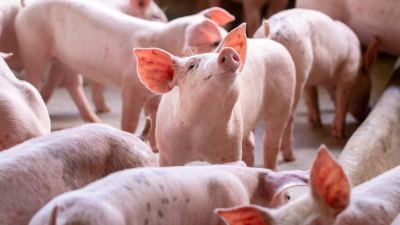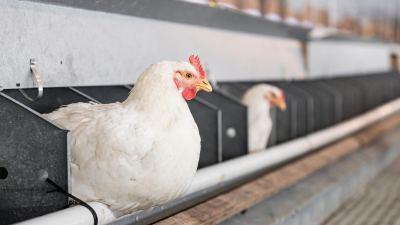Maximizing lifetime feed efficiency in pig production

Feed efficiency is one of the most crucial aspects of successful pig production. In the pursuit of sustainable and profitable production, it is essential to understand how genetics, pig nutrition and feeding management influence the way pigs convert feed into body weight.
What impacts feed efficiency, and what practical strategies can we implement to maximize productivity while minimizing environmental footprint?
Let’s find out.
An improvement in the feed efficiency of pigs will deliver three key benefits to pig producers:
1. Cost savings: Feed represents up to 70% of the total costs of production in pig farming. Improving feed efficiency means that pigs will convert feed into body weight more efficiently, requiring fewer resources to reach market weight. As a result, feed costs are reduced, leading to higher profit margins for producers.
2. Increased productivity: Efficient feed conversion allows pigs to grow and reach market weight faster, shortening the production cycle and increasing the number of pigs that can be raised and sold in a given period. As a result, farmers can achieve higher productivity and optimize production capacity.
3. Sustainability: Inefficient feed utilization leads to more feed wastage and greater environmental impact. This includes increased nutrient excretion in manure, which can contribute to pollution if not managed properly. By improving feed efficiency, farmers can minimize the environmental footprint of pig production, promoting sustainable and responsible agricultural practices.
Factors influencing feed efficiency
Feed efficiency in pigs is shaped by several factors, from the genetic makeup of the animals to the intricacies of their nutrition and the management practices employed. By unraveling these factors, we aim to equip pig producers with the knowledge to make informed decisions, enhance production practices, and contribute to a more efficient pig industry.
1. Genetics
Genetics plays a significant role in determining pig feed efficiency. The genetic makeup of pigs influences their growth rate, body composition, metabolism and nutrient utilization, all of which determine how efficiently they convert feed into body weight. For example:
- Feed conversion ratio (FCR): FCR is a key metric for feed efficiency and is influenced by genetics. Pigs with favorable genetics for feed efficiency require less feed to produce a unit of weight gain. Selective breeding can help identify and propagate lines of pigs that exhibit superior FCRs, leading to more efficient feed utilization.
- Lean-to-fat ratio: Genetic selection can also impact the lean-to-fat ratio in pigs. Leaner pigs generally have better feed efficiency, as lean tissue growth requires less energy compared to fat deposition. Leaner pigs convert feed more efficiently into muscle, making them more desirable for meat production.
2. Pig nutrition
Nutrition plays a crucial role in determining pig feed efficiency. The quality and composition of the pig’s diet affect its growth rate, nutrient utilization and overall health, all of which are key factors in feed efficiency. Here are some major ways that nutrition affects pig feed efficiency:
- Nutrient balance: Providing a well-balanced diet that meets the specific nutrient requirements of pigs at different stages of growth is essential for optimal feed efficiency. When their diet contains the right proportions of protein, carbohydrates, fats, vitamins and minerals, pigs can efficiently convert feed into body weight.
- Water availability: Access to clean and fresh water is crucial for pig feed efficiency. Dehydration can lead to reduced feed intake and hinder nutrient utilization.
3. Feeding management
Feeding management plays a critical role in determining pig feed efficiency. Proper feeding practices influence the amount of feed consumed, nutrient utilization, and overall growth performance. Examples in which feeding management affects pig feed efficiency include:
- Feed space and accessibility: Sufficient feed space is critical to avoid competition during feeding. Each pig should have enough space at the feeding trough to access the feed without being excluded by more dominant pen-mates. This ensures that all pigs have equal access to feed, supporting uniform growth and better feed efficiency.
- Feed form: The physical form of the diet can impact feed efficiency. Pelleted or extruded diets are generally preferred over mash diets, as they enhance digestibility and reduce feed wastage.
Exploring alternative feed ingredients that can improve feed efficiency while optimizing pig health and performance
There is wide interest in incorporating natural nutritional technologies in pig diets as a viable means to promote their lifetime growth and development and to minimize environmental damage.
Alltech has over 40 years of research and technical expertise in monogastric nutrition and has created comprehensive feeding programs designed to support pig performance and efficiency by ensuring optimal gut health and development and maximizing nutrient release from feed.
The gut health of pigs plays a significant role in the digestion and utilization of nutrients in feed and is strongly linked to performance parameters such as feed efficiency. Incorporated in Alltech’s nutritional programs for pigs are natural feed materials such as Actigen®, which have been demonstrated to significantly improve the intestinal structure of piglets post-weaning when supplemented in creep and starter diets (Figure 1). When the gut environment is enhanced, nutrient absorption and utilization increase, leading to better feed efficiency and an improvement in piglet weight gain.
Figure 1. Actigen improves the intestinal structure of the piglet intestinal tract post-weaning to boost nutrient absorption and utilization. The villi are taller and have a thinner wall to absorb nutrients.
Approximately 25% of the available nutrients in feed ingredients cannot be fully utilized by the animal, so it’s crucial to implement nutritional strategies focused on maximizing nutrient release. The Alltech nutritional programs utilize natural complexes, containing a unique blend of proprietary ingredients, that are designed to promote nutrient release and optimize feed digestibility. As such, these programs are proven to contribute to enhanced feed efficiency and overall growth performance in pigs (Figure 2).
Figure 2. Alltech’s natural complex Synergen® maximizes nutrient release from feed, resulting in improved weight gain and FCR in pigs.
From the studies presented here, supported by further trials around the globe, it can be concluded that Alltech’s nutritional technologies maximize nutrient utilization, resulting in better feed efficiency and higher growth rates.
Conclusion
In conclusion, feed efficiency is a fundamental aspect of pig production that impacts the economic, environmental and social sustainability of the industry. Emphasizing and optimizing feed efficiency through genetic selection, proper nutrition, and the use of novel feeding technologies and effective feeding management can lead to more sustainable, profitable pig farming productions, benefiting farmers and consumers alike.















